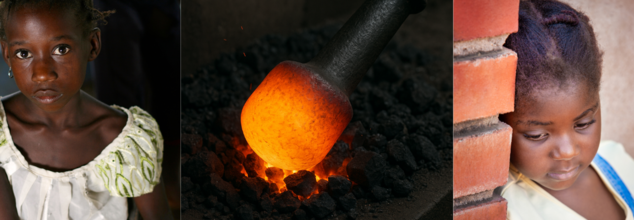
Credits: Canva & AI-generated
Why Is Breast Ironing Still Practiced In Some Cultures?
Adolescence is meant to be the time when your body grows. You become curious, sometimes confused, but in all, it is a healthy development, something that is bound to happen. However, for millions of girls across West and Central Africa, the natural process of puberty brings with it a painful, harmful tradition known as breast ironing or breast flattening. It is often practiced with the intention of protecting girls, but it causes irreversible physical and psychological damage.
What Exactly Is Breast Ironing?
As per a study published in the Journal of Global Health, titled Breast Ironing: A brief overview of an underreported harmful practice, breast ironing is a harmful practice that generally involves the repetitive pounding, pressing, ironing, rubbing, or massaging of a pubescent girl's breasts. It is done by using hard or heated objects, in order to attempt to stop or delay them from growing or developing, to make them flatter, or to make them disappear.
The practice uses a variety of objects, including heated grinding stones, cast-iron pans, ladles, hammers, wooden pestles, spatulas, spoons, brooms, or an electric iron. It can also be done by tightly wrapping or tying bandages, elastic compresses, clothes or belts around young girls' chests.
In 2006, a press release by the United Nations Population Fund listed breast ironing as one of the "five under-reported stories relating to gender-based violence." Countries where the practice is believed to occur include Benin, Burkina Faso, Cameroon, the Central African Republic, Chad, Côte d’Ivoire, Guinea-Bissau, Guinea-Conakry, Kenya, Nigeria, Togo, South Africa, and Zimbabwe.
Why Is It Done?
At its core, breast ironing stems from fear—fear of sexual attention, fear of early pregnancy, and fear of child marriage. In many of the communities where it is practiced, the appearance of breasts is believed to attract unwanted male attention and signal that a girl is ready for marriage. Families, particularly mothers, see breast ironing as a way to protect their daughters from rape, abduction, and early forced marriages.
Another perceived benefit is educational continuity. If a girl’s puberty can be delayed, she may be seen as a child for longer and therefore allowed to stay in school. Many mothers believe this painful trade-off gives their daughters a better chance at life.
However, experts argue that this practice is not a solution to child marriage or sexual violence. Instead, it reinforces harmful gender norms and contributes to cycles of silence and suffering.
What Are The Health Impacts Of This Act?
The physical effects of breast ironing are often severe. Girls suffer from tissue damage, burns, infections, and lasting breast deformities. The trauma can also interfere with future breastfeeding and lead to chronic pain.
Psychologically, many victims also report emotional distress, anxiety, low self-esteem, and trouble sleeping. It can last for years after the procedure is done. The act is also a secretive one and is done without the girl's full understanding.
According to global estimates, nearly 3.8 million girls worldwide have undergone breast ironing. In some parts of Cameroon, it is believed that one in three girls has been subjected to the practice. It is also prevalent in countries like Nigeria, Guinea, Benin, Chad, Côte d’Ivoire, Togo, Zimbabwe, and Kenya.
The issue is not limited to Africa. Reports have emerged from migrant communities in the UK, with estimates suggesting around 1,000 girls may have been affected, though the actual number is likely higher due to underreporting.

‘Miracle Baby’ Born Twice To A Mom With Cancer Mid-Pregnancy; Decoding The High- Risk Surgery
A baby boy in the United Kingdom was born twice—first in the womb and again at full term which was nothing short of an extraordinary medical feat that borders on the miraculous. Meet baby Rafferty Isaac, a symbol of survival, and his mother Lucy, whose determination and courage have moved the world.
For 32-year-old Lucy Isaac, a special needs teacher from Reading, her pregnancy journey took an unexpected turn during a routine ultrasound scan at 12 weeks. The scan revealed signs of ovarian cancer, a diagnosis that would terrify any expectant mother. Waiting to treat the cancer until after delivery was not an option, as the disease risked spreading rapidly. Yet performing conventional laparoscopic surgery during the second trimester was equally out of the question—her pregnancy had already advanced to the point where it complicated standard treatment approaches.
Time was running out. Lucy’s doctors at John Radcliffe Hospital in Oxford knew that urgent action was needed to save both mother and child. And so, they turned to an operation that had rarely been performed before—one that would test the limits of surgical precision and maternal strength.
What followed was a pioneering and high-risk five-hour surgery, led by consultant gynecological oncologist Dr. Hooman Soleymani Majd. The procedure involved temporarily removing Lucy’s womb—still carrying her unborn baby Rafferty—from her abdomen. This gave surgeons access to the cancerous tumors growing behind it. Wrapped in warm, sterile saline gauze to maintain body-like conditions, Lucy’s uterus remained connected to vital structures including the uterine artery, cervix, and umbilical cord, while two dedicated medics monitored Rafferty's heartbeat and temperature in real time.
For approximately two hours, Rafferty floated safely outside his mother’s body, held gently by doctors as his mother’s life hung in the balance. Her tumors, diagnosed as grade two, had already begun to invade surrounding tissues, complicating the delicate surgery even further. A surgical team of more than 15—consisting of surgeons, nurses, and anesthetists—worked in unison, navigating the tightrope between preserving life and preventing tragedy.
Despite the enormous risks, the surgery was a success. The tumors were removed, and the womb was carefully repositioned into Lucy’s body to allow the pregnancy to continue as naturally as possible.
Fast forward to January: after weeks of recovery and cautious monitoring, Lucy gave birth to a healthy baby boy, Rafferty Isaac, weighing 6 pounds 5 ounces. For Lucy and her husband Adam, who had undergone a kidney transplant just two years prior, the moment was deeply emotional.
“To finally hold Rafferty in our arms after everything we have been through was the most amazing moment,” said Adam, reflecting on the turbulent journey they had braved together.
Surgeon Dr. Majd, who had only performed the procedure a handful of times before, described the experience as one of the most emotional moments in his career. “It felt as if I had met him previously,” he said, referring to the rare encounter during surgery. Baby Rafferty’s safe arrival symbolized not just survival but a second chance at life.
What Is the Rare Surgery Doctors Performed?
The medical term for the procedure is extra-corporeal uterine surgery, an extremely rare and delicate operation that involves temporarily removing the uterus while preserving fetal life. Though rare, the surgery exemplifies the potential of maternal-fetal medicine when facing dual life-threatening conditions.
Throughout the procedure, maintaining the uterine temperature and blood supply was crucial to preventing fetal distress. The uterus was kept wrapped in warm sterile gauze, and medics ensured constant circulation through the uterine artery. Fetal heart monitoring continued throughout. The team used surgical planning strategies usually reserved for complex oncological operations, paired with advanced obstetric care.
This case also sheds light on how high-risk pregnancies can be managed innovatively through a multidisciplinary approach. It required not only gynecologic oncology but also obstetrics, neonatology, anesthesiology, and surgical nursing teams working seamlessly together.
Lucy considers herself incredibly lucky that her ovarian cancer was detected so early, even before symptoms appeared. Ovarian cancer often goes undetected until its later stages, making early diagnosis critical. According to statistics, approximately 7,000 women in the UK are diagnosed with ovarian cancer each year, and survival rates improve significantly with early intervention.
Baby Rafferty, now eleven weeks old, is thriving—a joyful reminder of how hope, medical innovation, and human courage can intersect to create what some might call a miracle. His story also serves as a beacon of possibility for expectant mothers facing complex diagnoses.

Credits: Freepik
Annual Report Shows Cancer Death Rates Declining, But Why Are More Women Being Diagnosed?
The latest annual report on cancer in the United States is a combination of good news and concern. While overall death rates from cancer continue to decline, an unexpected and troubling trend is emerging — more women are being diagnosed with cancer every year.
Published on April 21, 2025, in the journal Cancer, the 2024 Annual Report to the Nation on the Status of Cancer presents a complex image of progress and disparity. A collaborative effort of the National Cancer Institute (NCI), Centers for Disease Control and Prevention (CDC), American Cancer Society (ACS), and North American Association of Central Cancer Registries (NAACCR), the report provides a complete picture of U.S. cancer incidence and death trends between 2001 and 2022.
One of the brightest findings in the report is that cancer mortality rates have been falling steadily for men and women since 2001. The decline continued even in the early years of the COVID-19 pandemic.
The American Cancer Society credits this decline to a 32% reduction in cancer death rates between 1991 and 2019. This has meant an estimated 3.5 million deaths from cancer prevented, thanks to earlier diagnosis, changes in lifestyle, and medical advances.
Clerk of court records show this progress has included the decline of lung cancer death — one of the major factors in cancer-related deaths. The mortality rates among other smoking-associated cancers have significantly decreased as a direct result of declining smoking incidence over the years.
Better screening procedures have had a significant bearing on lowering death due to cancer. For instance:
Mortality from colorectal cancer has fallen by 52% in adults aged 50–75 years, largely as a result of regular screening.
Deaths from breast cancer have fallen by some 40% since the use of mammography became more common.
These results highlight the effectiveness of early diagnosis in enhancing survival and reducing disease burden.
Prevention Through Lifestyle Changes
As treatment advances are making front-page news, the report insists on the critical importance of prevention. Anti-smoking campaigns have dramatically reduced prevalence from more than 40% in the 1960s to only 14% nowadays, leading to important declines in tobacco-related cancers.
Public health initiatives urging healthier eating, more exercise, and weight control have also played a role in reducing risk. Remarkably, as many as 40% of cancers have been estimated to be preventable by such changes in lifestyle.
Impact of COVID-19 on Cancer Care
The report isn't afraid of the pandemic disruption to healthcare services. Cancer rates fell significantly in 2020, not as a result of genuine falls in disease but as a result of postponements in screening and diagnosis. By 2021, figures bounced back, suggesting that normal healthcare access resumed.
This volatility unearthed the compelling necessity for unwavering continuity of access to cancer care during even public health emergencies. The states exhibited uniform trends in the 2020 decline, apart from differing policy responses to COVID-19.
Why More Women Are Getting Diagnosed?
Even with the encouraging news on cancer mortality, concerning is the fact that cancer incidence in women has been increasing steadily. Between 2003 and 2021, the number of new cases in women ticked up slightly each year — except for a temporary decrease in 2020, when it happened during the pandemic. A number of explanations are probably to blame:
1. Obesity-Related Cancers Are on the Rise
The report identifies an increasing number of cancers associated with obesity, many of which disproportionately affect women. These include:
- Breast cancer in women
- Uterine (endometrial) cancer
- Pancreatic cancer
- Colon and rectal cancer
- Kidney and liver cancers
Rates of obesity have been consistently rising in the U.S., and women tend to experience distinctive metabolic and hormonal alterations (e.g., post-menopause) that can make them more susceptible to these cancers.
2. Enhanced Screening and Awareness
In part, the increase may be an artifact of better screening and female health awareness. More detection of early-stage cancer such as breast and cervical cancer — particularly in women who receive regular healthcare — is a healthy trend, albeit one that can temporarily boost incidence rates.
3. Environmental and Hormonal Factors
Endocrine-disrupting chemicals, hormone replacement therapy, and chronic exposure to estrogen (resulting from delayed childbearing or lower pregnancy rates) can cause elevated risk for specific cancers in women, such as breast and uterine cancer.
4. Racial and Ethnic Disparities in Cancer Diagnosis
The report points out that American Indian and Alaska Native women now have the highest cancer rate among all racial and ethnic female populations. This may be attributed to various factors — such as limited access to preventive care, socioeconomic challenges, environmental exposure, and genetic susceptibility.
Is There A Gender Disparities in Cancer Care?
The growing incidence of cancer among women underscores the necessity for gendered approaches to cancer prevention. While deaths are declining — a testament to progress — further action must be taken to:
- Combat the epidemic of obesity
- Provide access to early detection and treatment for all
- Target special hormonal and environmental risk factors in women
Healthcare systems need to respond to this changing environment with a comprehensive, integrated, and preventive strategy for cancer control that involves women from all walks of life.
The 2024 Annual Report on Cancer presents a reassuring vision of gradual reductions in cancer deaths due to decades of research, public health efforts, and medical progress. Yet the simultaneous increase in cancer incidence among women requires closer scrutiny.

Biological Age vs. Chronological Age: Signs Your Body Is Aging Prematurely
Why your body’s real age might be older or younger than the number on your birthday cake. Aging is a natural part of life, but what if your body is aging faster than it should? While your birth date gives you a chronological age, your biological age tells a more nuanced, and often more accurate, story about how well or poorly your body is holding up. In recent years, scientists have emphasized the significance of biological age as a powerful indicator of health risks, longevity, and overall physiological decline.
Chronological age is simple it’s the number of years you’ve been alive. Biological age, on the other hand, measures how your body functions on a cellular and molecular level. It considers markers like DNA methylation, telomere length, and inflammation, offering a clearer picture of your physical health.
For example, someone may be 45 years old chronologically but have a biological age closer to 55 due to poor lifestyle choices, chronic stress, or disease. Conversely, a person in their 60s who leads a healthy life might have the biological age of someone in their 40s.
Emerging research confirms that biological age is a stronger predictor of mortality and disease than chronological age, especially in critically ill patients. This insight is shifting the healthcare paradigm toward personalized, preventative strategies that focus on biological aging.
Role of Biomarkers in Biological Aging
To determine biological age, researchers assess various biomarkers, each offering a snapshot of different aspects of aging.
Telomere Length: Telomeres are protective caps at the ends of chromosomes. They shorten each time a cell divides, and when they become critically short, cells either stop functioning or die. Accelerated telomere shortening is linked with premature aging and age-related diseases.
Epigenetic Clocks: These tools, including DNAmAge, Hannum, PhenoAge, and GrimAge, measure changes in DNA methylation—chemical modifications that influence gene expression. PhenoAge and GrimAge, in particular, closely correlate with telomere length and can predict disease onset and lifespan with remarkable accuracy.
Inflammation Markers: Chronic low-grade inflammation, also known as “inflammaging,” is a key driver of age-related disorders. Blood levels of C-reactive protein (CRP) and various cytokines can reveal how inflamed—and therefore how aged—the body really is.
These biomarkers collectively help gauge the true biological toll life has taken on the body, far beyond what a birth certificate can tell you.
Health Risks of Premature Biological Aging
Biological age has real-world health consequences. Individuals whose biological age outpaces their chronological age are at higher risk for chronic diseases, including cardiovascular conditions, cancer, and neurodegenerative disorders.
Heart Disease and Cancer: Aging naturally compromises the cardiovascular system. But accelerated aging, especially in the presence of risk factors like obesity, diabetes, or hypertension, hastens this decline. Likewise, age-related changes such as inflammation, mitochondrial dysfunction, and cellular senescence create fertile ground for cancer development.
Cancer Survivors and Cardiovascular Risks: Cancer therapies, particularly in older adults, may further accelerate biological aging. Studies show that survivors over age 65 face increased cardiovascular risks, often surpassing cancer as the leading cause of death in this group.
Signs to Watch For You Aging Faster Than You Should
While diagnostic tools can assess biological age in a clinical setting, your body often sends early warning signals of premature aging. If you’re noticing these signs, it may be time to reassess your health habits.
1. Sun-Damaged Skin
Excessive UV exposure breaks down collagen and elastin, leading to sagging skin, fine lines, and pigmentation issues. Skin that appears leathery, paper-thin, or mottled may signal underlying cellular damage.
2. Stiff Joints
Unexplained joint pain or reduced flexibility in your 30s or 40s can reflect early cartilage wear—an age-related phenomenon that may be sped up by sedentary habits or inflammation.
3. Early Hearing Loss
Hearing changes are expected with age, but if you're experiencing diminished hearing sensitivity before age 60, noise-induced damage from headphones, loud environments, or machinery could be aging your auditory system prematurely.
4. Accelerated Hair Loss
While graying and thinning are normal, sudden shedding—especially after stress—may be linked to hormone shifts or inflammatory processes that mimic aging.
5. Weak Immune Function
If you frequently catch infections or struggle to recover, your immune system might be aging faster than it should. Chronic stress and poor nutrition can accelerate immune aging, raising susceptibility to disease.
6. Cognitive Fog and Memory Lapses
Occasional forgetfulness is normal, but persistent memory problems or reduced focus in midlife may be signs of neurobiological aging driven by poor sleep, stress, or lack of mental stimulation.
7. Bruising Easily
Thinning skin and fragile capillaries increase bruising with age, but if it’s happening too frequently—or suddenly—it might reflect premature structural breakdown of connective tissues.
8. Irregular Menstrual Cycles
Hormonal shifts that occur in perimenopause usually start in the 40s. But if you’re seeing major menstrual changes in your 30s, early menopause or ovarian aging could be to blame.
Can You Reverse or Slow Down Biological Aging?
The good news: biological age is modifiable. Interventions that reduce oxidative stress, improve metabolic health, and lower inflammation can reverse certain signs of accelerated aging.
Nutrition: Diets high in fresh produce, lean protein, and healthy fats combat inflammation and support cellular health. Reducing sugar and refined carbohydrates may also protect your skin and brain.
Exercise: Regular physical activity boosts cardiovascular health, builds muscle mass, and slows telomere shortening.
Sleep and Stress Management: Prioritizing deep, restful sleep and adopting stress-relief techniques like mindfulness and therapy can positively impact your biological age.
Preventive Healthcare: Getting regular screenings and addressing metabolic conditions early on helps keep your biological age aligned with or younger than your chronological one.
© 2024 Bennett, Coleman & Company Limited

